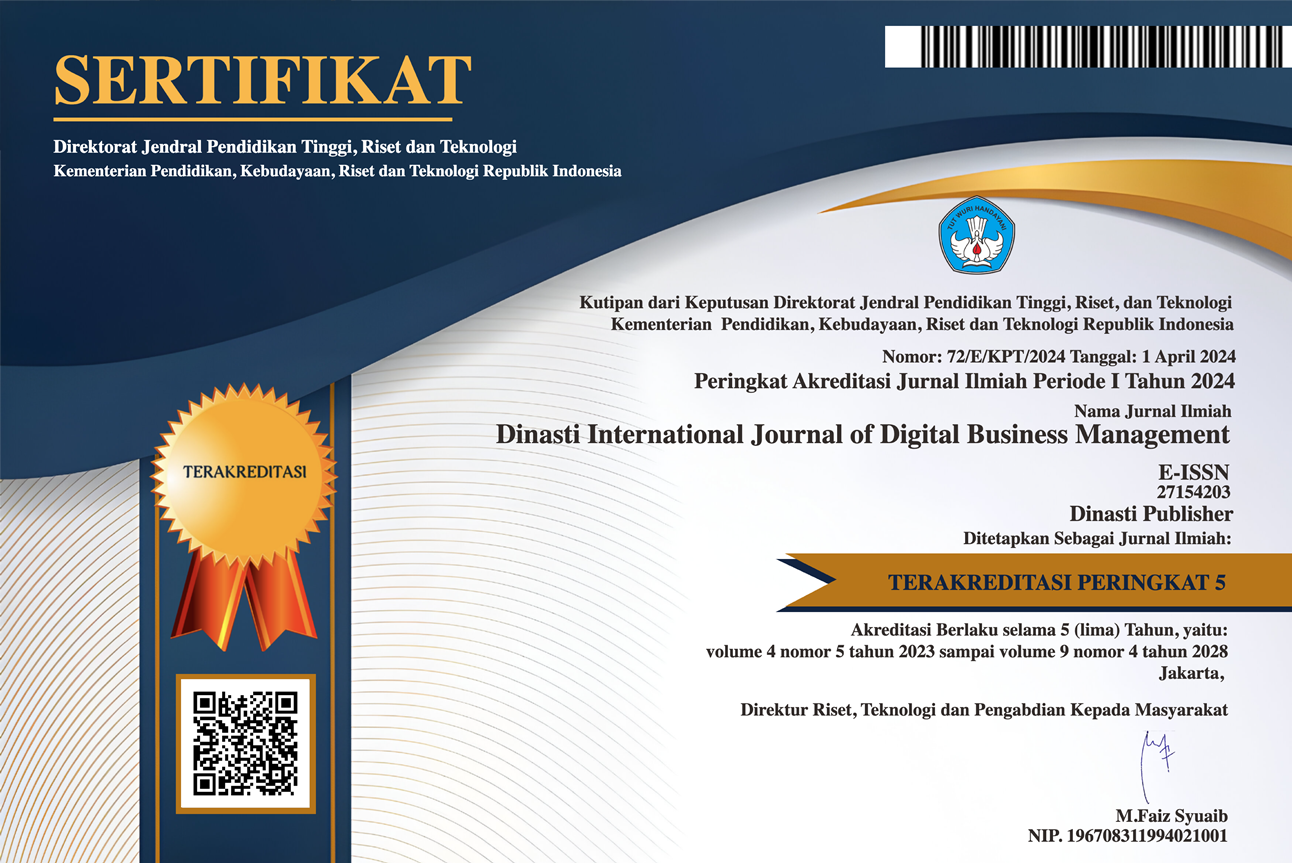Analysis of the Influence of Perceived Value on Gen Z's Revisit Intention with Customer Satisfaction as An Intervening Variable at The Museum Bahari Jakarta
DOI:
https://doi.org/10.38035/dijdbm.v5i6.2907Keywords:
Perceived Value, Customer Satisfaction, Revisit Intention, Generation ZAbstract
The aim of this research is to analyze the influence of perceived value or perceptions related to the values that generation Z has and how to increase this value so that there is satisfaction that creates interest in returning to the Maritime Museum. The research method used is quantitative with questionnaires as a means of data collection. Data was distributed to 100 generation Z respondents who had visited the Jakarta Maritime Museum. The data analysis technique used is path analysis to test the relationship between the variables studied. The research results show that quality value has a significant effect on revisit intention with a p-value of 0.014. Then the quality value on customer satisfaction is significant with a p-value of 0.000. The emotional value of revisit intention is not significant with a p-value of 0.404. Then emotional value on customer satisfaction has a significant effect with a p-value of 0.000. The price value on revisit intention is also significant with a p-value of 0.029 and the price value on customer satisfaction is also significant with a p-value of 0.005. The latest results also show that customer satisfaction is significant on revisit intention with a p-value of 0.000. Based on the results of this research, it can be concluded that by increasing values such as quality, emotional and price, it will have an impact on the satisfaction that visitors feel, and if this satisfaction is in line with their expectations then there will be an interest in visiting again from generation Z. Museum Bahari Jakarta needs to focus on developing service quality, as well as presenting information that is not only educational but also interesting, as well as modernization efforts by combining digital elements in museum collections and exhibitions.
References
Aeni, S. N. (2022). Memahami Karakteristik dan Ciri-ciri Generasi Z. https://katadata.co.id/berita/nasional/6226d6df12cfc/memahami-karakteristik-dan-ciri-ciri-generasi-z
Chotimah, S., & Wahyudi, H. D. (2017). Pengaruh Perceived Value Terhadap Revisit Intention: Mediasi Customer Satisfaction Pada Pengunjung Jawa Timur Park I Batu. Sumber, 4, 145–328.
CNN Indonesia. (2022). Sejarah Singkat Kota Jakarta yang Bermula dari Sunda Kelapa. https://www.cnnindonesia.com/nasional/20220620174224-31-811264/sejarah-singkat-kota-jakarta-yang-bermula-dari-sunda-kelapa
Hair, J. F., Black, W. C., & Babin, B. J. (2010). Multivariate Data Analysis: A Global Perspective. Pearson Education.
Handayani, Y., & Harie, S. (2021). Museum Bahari Sebagai Media Pembelajaran Sejarah. Alur Sejarah: Jurnal Pendidikan Sejarah, 4(1). https://journal.lppmunindra.ac.id/index.php/alursejarah/article/view/9175
Humairo, A., & Panuntun, B. (2022). Perilaku Overconfidence, Loss Aversion, Dan Herding Bias Dalam Pengambilan Keputusan Investasi Pasar Modal Pada Generasi Z. Selekta Manajemen: Jurnal Mahasiswa Bisnis & Manajemen, 1(6), Article 6.
Istina, D. (2022). Keberadaan dan fungsi museum bagi Generasi Z. Jurnal Tata Kelola Seni, 8(2), 95–104.
Julianis, A., & Wulandari, D. P. (2023). Pengaruh Perceived Value Terhadap Minat Gen Z Berkunjung Kembali Ke Museum Kereta Api Kota Sawahlunto. Jurnal Visionida, 9(2), Article 2. https://doi.org/10.30997/jvs.v9i2.10836
Kementerian Pendidikan, Kebudayaan, Riset, dan Teknologi. (2019). Pengertian Museum—Sistem Registrasi Nasional Museum. Sistem Registrasi Nasional Museum Kemdikbud. https://10.24.26.63/pengertian-museum
Mahmudah, A. R. (2019). Pengaruh Karakteristik Generasi Z Terhadap Motivasi Belajar Mahasiswa Pendidikan Agama Islam Angkatan 2017 & 2018 Universitas Islam Indonesia Yogyakarta. https://dspace.uii.ac.id/handle/123456789/15388
Mowen, J. C., & Minor, M. (1995). Consumer Behavior. 4-th ed. Jersey: Prentice Hall.
Nurohmah, A. (2015). Anak Muda Nggak Minat ke Museum, Kalaupun Berkunjung Cuma Buat Selfie. Brilio. Net.
Pemernitah Provinsi DKI Jakarta. (2023). Sejarah Jakarta. https://www.jakarta.go.id/sejarah-jakarta
Peraturan Pemerintah (PP) Nomor 66 Tahun 2015 Tentang Museum, Pub. L. No. 66 (2015).
Purwanto, A., Asbari, M., & Santoso, T. I. (2021). Analisis Data Penelitian Marketing: Perbandingan Hasil antara Amos, SmartPLS, WarpPLS, dan SPSS Untuk Jumlah Sampel Besar. Journal of Industrial Engineering & Management Research, 2(4), Article 4. https://doi.org/10.7777/jiemar.v2i4.178
Saragih, M. G., Aditi, B., & Suyar, A. S. (2022). Perceived Value, Kepuasan dan Revisit Intention Wisatawan pada Lokasi Wisata. Journal of Business and Economics Research (JBE), 3(2), Article 2. https://doi.org/10.47065/jbe.v3i2.1717
Suparna, G., & Riana, I. G. (2022). Determinan Revisit Intention Pengunjung Museum Dalam Perspektif Experiential Marketing. EKUITAS (Jurnal Ekonomi Dan Keuangan), 6(1), 22–42. https://doi.org/10.24034/j25485024.y2022.v6.i1.4768
Tribunnews. (2021). Museum Bahari. https://www.tribunnewswiki.com/2021/05/21/museum-bahari
Undang-Undang (UU) Nomor 10 Tahun 2009 Tentang Kepariwisataan, 2009, Pub. L. No. 10 (2009).
Wang, E. S.-T., & Yu, J.-R. (2016). Effect of product attribute beliefs of ready-to-drink coffee beverages on consumer-perceived value and repurchase intention. British Food Journal, 118(12), 2963–2980. https://doi.org/10.1108/BFJ-03-2016-0128
Downloads
Published
Issue
Section
License
Copyright (c) 2024 Melissa Priskila Saksono, Imam Ardiansyah

This work is licensed under a Creative Commons Attribution 4.0 International License.
Authors who publish their manuscripts in this journal agree to the following conditions:
- The copyright on each article belongs to the author(s).
- The author acknowledges that the Dinasti International Journal of Digital Business Management (DIJDBM) has the right to be the first to publish with a Creative Commons Attribution 4.0 International license (Attribution 4.0 International (CC BY 4.0).
- Authors can submit articles separately, arrange for the non-exclusive distribution of manuscripts that have been published in this journal into other versions (e.g., sent to the author's institutional repository, publication into books, etc.), by acknowledging that the manuscript has been published for the first time in the Dinasti International Journal of Digital Business Management (DIJDBM).















































